
Table of Contents
The Religious Roots of Alchemy
Alchemy is a seventeenth-century name given to the ancient knowledge of what we are made of, having a pervading presence in Sacred Scriptures. It has its place in one of the seven pillars of the house of wisdom (Proverbs 8:12, 9:1), enlightening us on the indissoluble link between matter and spirit. The doctrine of the four elements air, earth, water, and fire dealing with their essences and combinations is central to it.

Common to the 4 religions—Judaism, Zoroastrianism, Christianism, and Islam—are the 4 elements of alchemy that should not be confused with the chemical ones derived from them. This essay only addresses how the 4 elements of alchemy are present in the deep structure of matter. A detailed Scriptural account of how they became what matter is today is one of the topics discussed at length in the book Fundamentals of the Creation.
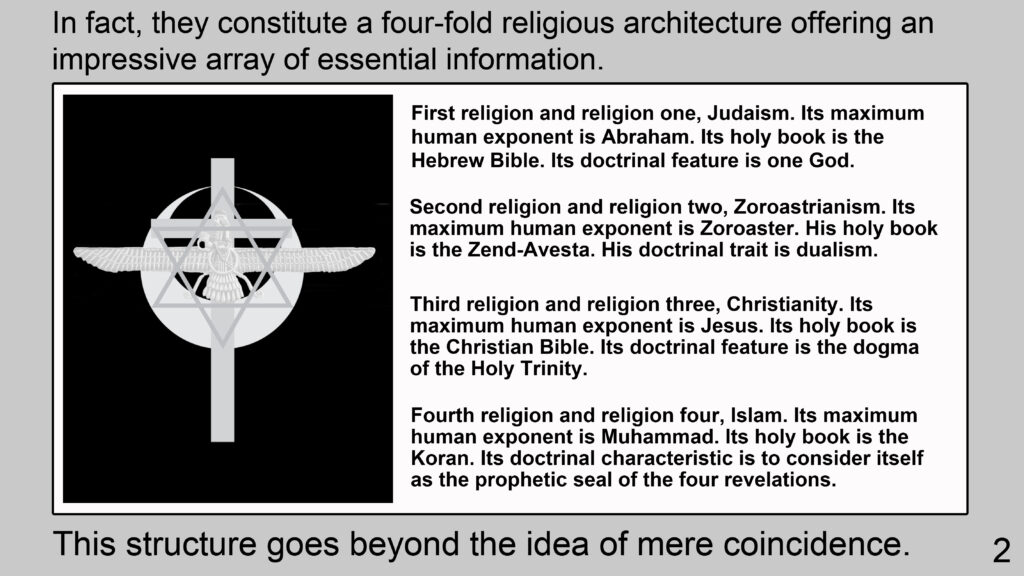
Being Genesis 1:1, a description of the basic building block of Creation, it is worth noting the early presence of the number 4. Particularly in word 1 את (tav alef) representing God as origin and finality, and whose gematria value is 401. In religion 2, Zoroastrianism, it is hard to miss the binary type of tetramorphisms that the Zend-Avesta in Yasna LVII presents as the essence of Sraosha (the messenger of Ahura Mazda and incarnation of his word). He appears in a quadriga with four horsemen and a glorious countenance: “white and bright, beautiful and powerful.”

In connection with number 4, it is desirable to choose a suitable basis of representation to lay out the scriptural accounts of Creation and the irreducible representations of the tetramorphic symbolisms in the 4 main religions from the Fertile Crescent. However, this quaternary formulation goes beyond these 4 religions, as the Pythagorean Tetractys and the four-headed god Brahma from the Hindu triad demonstrate. The chosen basis should also be amenable to representing the four elements of alchemy and their exteriorizations in physical matter.

The Elements of Alchemy
As Genesis 1:1 suggests, our quaternary basis of representation should contemplate two domains: heaven and earth. In the atxyz manifold, the plane at is the only one capable of hosting the irreducible polygonal expansion entirely in the heavenly domain. We will associate its a and t independent directions with 2 manifestations, the quintessence—Latinate of the fifth essence— and air. For being outside of the space-time manifold txyz, the former won´t be considered a protoelement. However, as human observers, we tend to anthropomorphize ways of being as we will do with the quintessence.
In what follows, we will call Anointed One the way of being of quintessence, and his role is to realize all events in perpetuity a. Air (Ruach) is the constitutive protoelement of the Holy Spirit determining events in time t. Together they form what some mystical circles call the waters of the cloud, often seen in Christian iconography surrounding God in the heavens. For the sake of representation, we may think of 2 tetrads or twins, one headed by the Anointed One/quintessence and the other by the Holy Spirit/air. Unless otherwise stated, the protoelement air leads all the tetrads in this essay.
In John 3:8, Jesus associates air displacements with the actions of the Holy Spirit: “The wind blows where it pleases … so is everyone born of the Spirit.” The lower triad formed by the 3 planes xy, yz, and zx represents Earth, where earthly creatures dwell. Curiously enough, planet Earth is also planet number 3, the planet in which ternary traits of Creation, as a whole, resolve the pending issues of their archetypes.
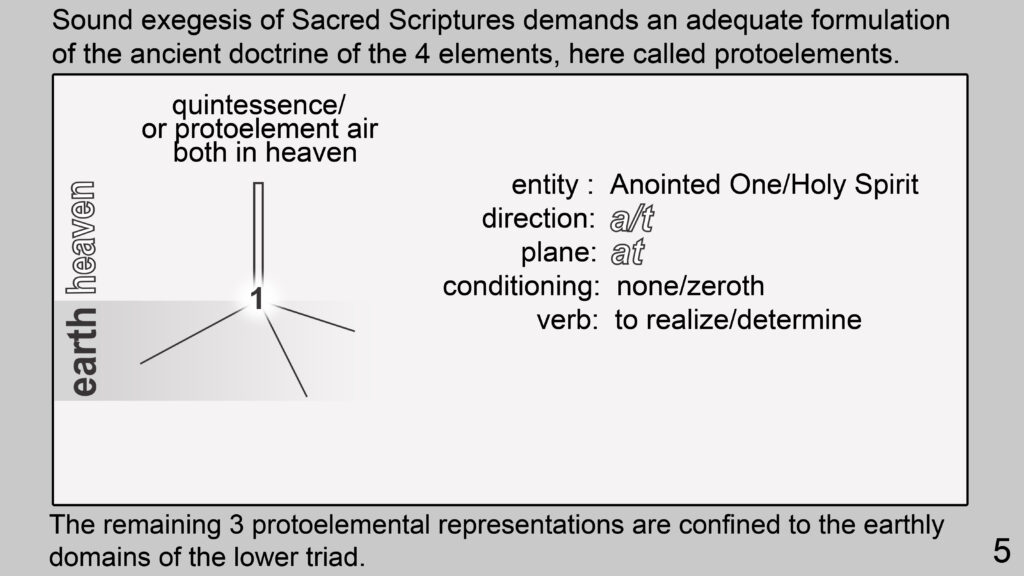
The unitary element of alchemy belonging to the lower triad is earth. Air and earth are considered masculine for being numerically odd. Together they form what R. Levi (the third century AD) called the masculine upper waters. The previous definition, albeit symbolic, points to an important feature of this configuration representing the priesthood. The rule for the upper waters is that they cannot pursue opposing goals. Fresh water discharged from the sky that flows downward in torrents and rivers on the earth symbolizes these upper waters. The “Discrimination” surah of the Koran calls them sweet and drinkable.

The binary element of alchemy in the lower triad is water, considered the archetype par excellence of the feminine. Three pairs complement the earth configurations, each having two masculine components with opposing attributes—labeled as chiaroscuro contrast. For example, consider juxtaposed opposites—like in counter-polarization and counter-rotations— whose most conspicuous representatives are pairs of opposites in all excitation states. The Zend-Avesta describes water in Yasna XXX as two primal spirits with opposing endeavors. The Buddhist three-pronged vajras portray a physical vacuum as two divergent masculine components in opposition (the straight ones), sided by two feminine counter-rotations (the curved ones).
When opposites alternate with cyclical permutations, we get rotations or waves. Primordial waters, reigning at the beginning in most cosmogonies, are examples of the feminine archetype. According to Genesis 1:2, at the beginning: “the Spirit of God (air) was hovering over the surface of the waters.” The “Discrimination” surah of the Koran describes the waters of the lower triad as salty and bitter. The two components of the feminine or lower waters are of the same kind but have opposing endeavors.

The fourth element of alchemy is fire, considered masculine for being numerically odd. The use of primary colors to identify the 3 aspects of fire is merely a matter of convenience due to the analogies involved. Its 3 interrelated components always appear as a trio of cyclical permutations, analogous to those of the chiaroscuro contrast in water. However, number 3 is fundamental to the creation ruling in many aspects, including God´s immanence. Therefore, it is an issue to deal with great care and not only in connection with the alchemical element. Religious literature and traditions consider fire as a means to purify evil, and sometimes they stress its ternary trait.
The connection between number 3 and evil in the Hebrew Bible is not as evident as in other Scriptures written after Zoroaster reformed Mazdeism. Perhaps the most relevant association is in the Book of Genesis, where the wrongdoings of the serpent defying God are recounted in chapter 3:1-6. In the sacred book of the religion 2, the Zend-Avesta is where we find the most detailed account of the connection between igneous evil and the number 3. According to Yasna IX, the dragon Dahaka has 3 mouths, 3 heads, 6 eyes, thousands of powers, and an awesome force and is the devil of the lie.
In the Christian sacred books, we find some direct and indirect references, like in the episode of the triple temptation of Jesus in the desert reported by 3 of the 4 Gospels: (Mark 1:12,13), (Mathew 4:1-10) and (Luke 4:1-9). But probably the best known Christian association between the number 3 and evil appears in the Apocalypse of John: “whoever has knowledge let him obtain the figure of the beast because it is the number of a man. The number is 666.” By man, John refers to the ternary formula of the human being (1&2) totaling 3 as that of the igneous Satan. The number 666 corresponds to the vertices of 3 primordial hexagons (blue, green, and red, or their anti’s, yellow, magenta, and cyan) or the 3 sets of 6 “colored” polygons of the 6-day creation in the 3 earthly planes xy, yz, and zx.
The Koran establishes in the “Sad” surah that fire is the substance from which the jinn are made, including Iblis/Satan, their maximum representative. The surah also gives a detailed account of how and why Iblis/Satan defied God’s order to bow before his human creation and became the root of evil and sin. In the Koran, there are a few indirect references regarding the ternary trait of Iblis/Satan, such as in “Those Sent Forth” surah, where its fire is described as a formation of 3 columns of smoke.
However, during the annual pilgrimage (Hajj), at least once in a lifetime, Muslims must go for 3 days to Mina, where 3 pillars are stoned. The 3 monoliths al-Aqaba, al-Wusta, and al-Ula mark the place of the triple temptation to the family nucleus of Abraham against a test imposed by God. The patriarch, by command of the archangel Gabriel, stoned Iblis/Satan for tempting him, his wife Hagar, and his son Ishmael to disobey the divine order.
Advocates of perennial philosophy may want to compare the above to Xiuhtecuhtli, the ancient Aztec god of fire, permanently residing in the midst of 3 stones—like in today’s traditional Mexican home fires—framed within the 4 corners of the cosmos. These stones may signal the “3 gates of hell” to which the Bhagavad Gita refers.

Regarding the transcendence of God, nothing will be said in this series of essays, which only deals with his immanence. The immanent aspect of God is like an absolute freedom of expression in action made light that the archetypal elements of alchemy refract in many ways. Feminine archetypes, for example, obliterate the refracted absolute freedom of expression due to internal destructive interferences. Free will is present in every odd combination of the elements of alchemy, in the image of God, the 1.
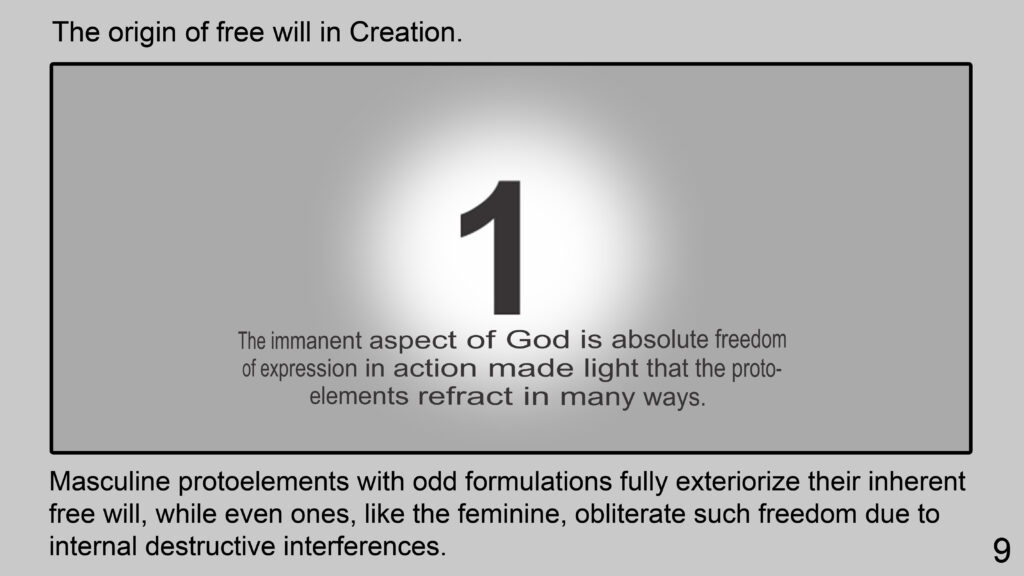
Formation of the Human Being
The archetype of the human being consists of the indissoluble union of a unitary element and a binary one. There are then two main versions, the heavenly one formed by air and water, and the earthly one formed by earth and water. The masculine (odd) plus the feminine (even) enjoy free will due to their ternary formulation.

The archetypal human being formula 1&2 is of the utmost importance for the Sacred Scriptures, judging by its presence in the aspect ratios of the Tabernacle built by Moses to house the most sacred and King Solomon’s Temple. There is no father without a mother, and for that reason, the word father in the Hebrew language is אב, whose gematria is 2+1, similar to 1&2, our synthetic formula for the human being. The priesthood institution represented by the upper or masculine waters 1&1 defines the aspect ratios of the holy of holies in both sanctuaries. The two components of the masculine or upper waters are of different kinds but have the same endeavors, in stark contrast with the feminine ones.
One good example of human archetype representation is the metamessage of the Gospel´s architecture. The German critic J. Griesbach was the first to group the Gospels of Mark, Matthew, and Luke under the “synoptic” denomination—as in a lower triad—to distinguish them from the theological symbolism of the Gospel of John—outside the lower triad as air or the Holy Spirit. In this sense, recent analyses have focused on the issue of some shared material in two synoptic Gospels, Matthew and Luke, known as tradition Q (Q, Quelle, “source” in German).
While it is true that the three synoptic Gospels contain “common material,” those of tradition Q—Matthew Luke (water)—have a greater proportion of it. In this way, it is possible to discern two traditions, that of Mark and the Q tradition of the source of the sayings. Thus the synoptic Gospels offer a representation of the earthly human being, with Mark representing earth (man) and Matthew and Luke figuring as water (woman).
The Gospels of John and Mark figure as air and earth, or spirit and man, and were written in Greek from left to right, as they should if representing the concurrent upper or masculine waters. On the other hand, early Matthew and Luke of the Q tradition were written in Aramaic and Greek with contrary writing senses, symbolizing the chiaroscuro contrast of the waters they represent.
There are many mentions of the creation of man in the Koran; in fact, there are so many that any superficial reading could be somewhat confusing. By focusing attention on the components used by God in his creation of man, the issue can be settled in many cases by interpreting the word man as “an earthly human being.” For example, the “Rock,” “Discrimination,” “Romans,” “Adoration,” and “Believer” suwar mention the elements used in the formation of the human being. Among these elements are dust from the earth, moist earth in the form of clay, mud, and water.
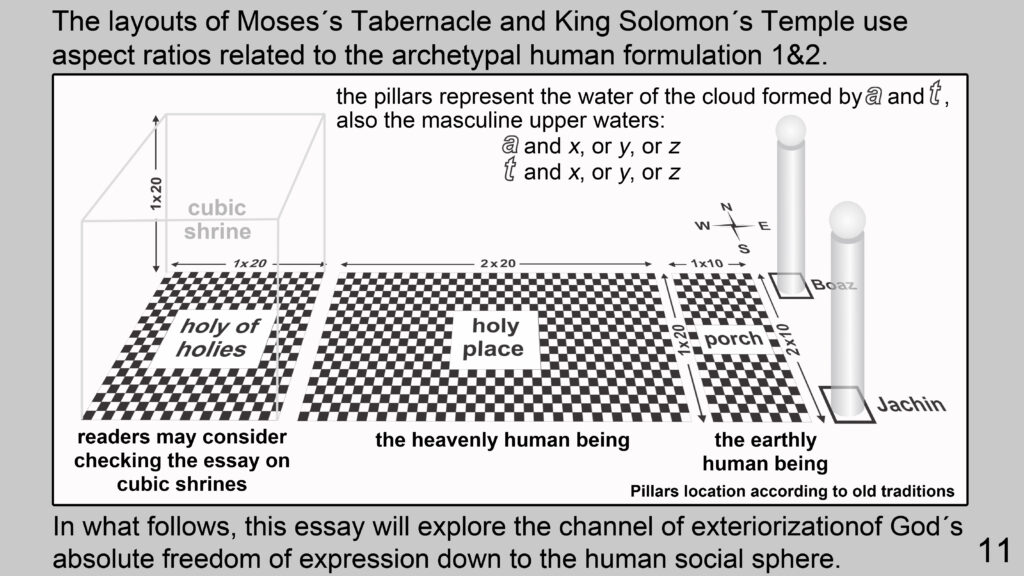
The archetypal human formula 1&2 is the recipe for the projection powder to fulfill the great work of spiritual alchemy. Mystery has always surrounded the true intentions of the masters of alchemy and their secret formulas. Besides some outstanding Catholic clerics well acquainted with the deep secrets of occult sciences and alchemy—like Gerbert of Aurillac (Pope Sylvester II) and the Dominican Albert the Great—there was a large number of savants sometimes protected under the umbrella of secret societies. In any case, most traditions hold that their quest was to produce gold, a religious and cultural symbol for incorruptibility, sanctity, and eternal life.
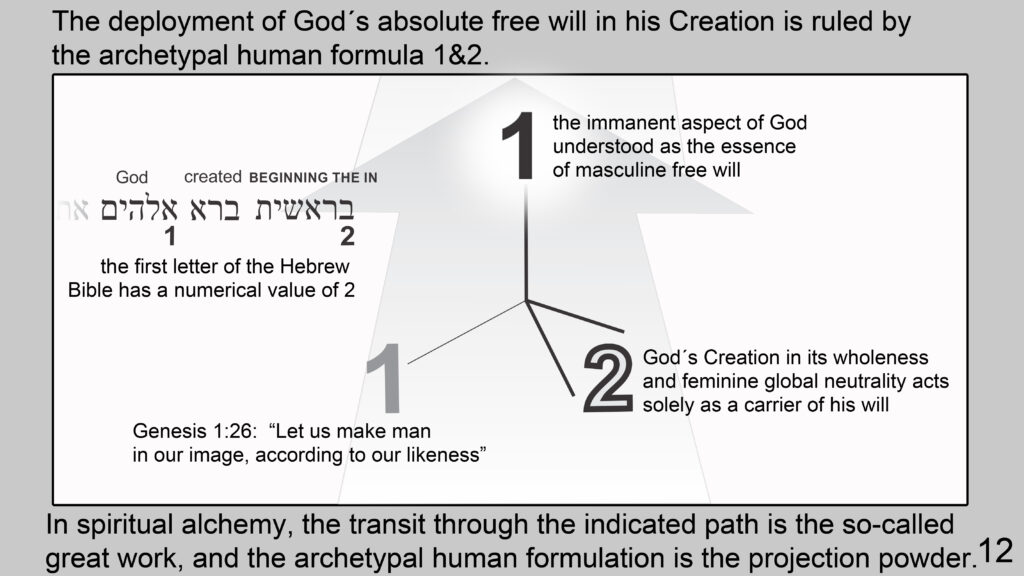
Natural Representations, the Gospel According to Nature (video)
This section begins by using gematria to articulate the gauge symmetries of the standard model of particle physics, U(1), SU(2), and SU(3). If the human formula defines the relationship between God and his Creation, one would expect some transitivity in its physical deployment. As expected, it is possible to find the 1&2 formulation at the root of the physical forthcoming of Creation in field and particle generations. Here, we conceive of fields as ever-expanding arrays of possible locations for the source. Quantum field theory offers a probabilistic description of the behavior of physical fields and elementary particles, fully compatible with these expansions of possibilities far from their point sources.

Beyond the field expansion, defining new possibilities for the occurrence of the source is the dynamic realization of its displacement through the so-called particle-wave duality. The particle formation corresponds to the unitary masculine component, while the wavy phenomenon—with its sequentially opposed real-valued functions—is the feminine one.

Charged physical particles like electrons have their divergent field or masculine behavior coupled to their wavy or feminine companion, consisting of field excitations. The coupling of matter and light, described by quantum electrodynamics, addresses these issues with great accuracy. The embedding of the alchemy element fire in the four directions is not observable because the cyclical permutations of color charges keep everything neutral. By convention, the electron’s charge is negative.
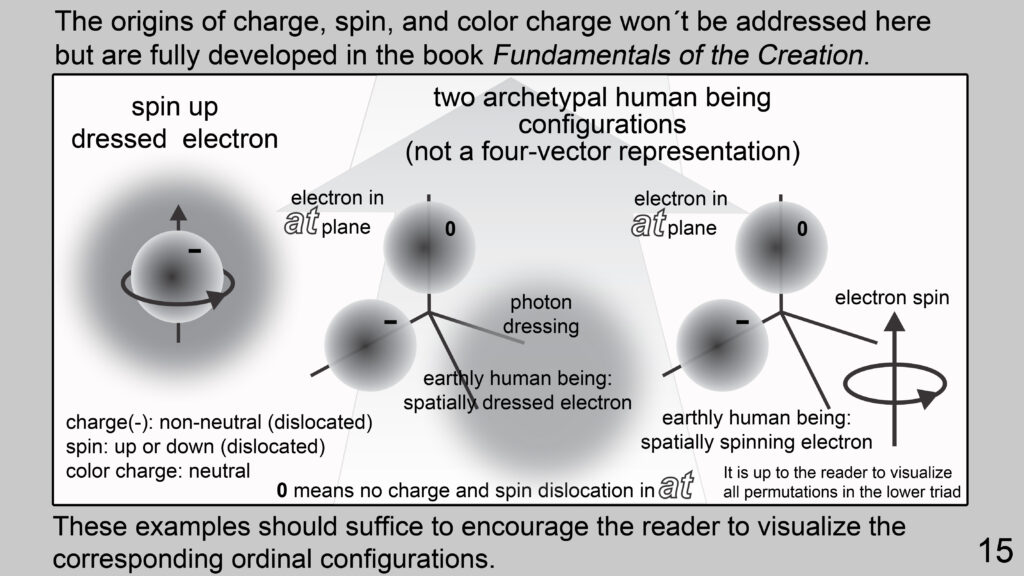
The proton is a subatomic particle with a positive charge but not an elementary one since it has 3 valence quarks (uud). Each quark has a different color charge due to the dislocation in the lower or spatial triad of cyclically permuted ternary attributes of the protoelement fire (recall slide 8). Spatial dislocation of attributes, in general, is a consequence of an unprecedented event fully developed through several chapters in the book Fundamentals of the Creation.
The neutron—the isospin partner of the proton—also has 3 valence quarks endowed with color charges, one up and two down (udd), with a net electric charge equal to zero. Protons and neutrons display interference by the human archetype (1&2) absent in other particles like the delta resonance Δ++ (uuu).

From an ontological perspective, we could say that the color charges—described by quantum chromodynamics—are the earthly (xyz) and material representations of what Christian theologians call the three ways of being (persons) in their modeling of the Imago Dei of the triune God. The exchange of force carriers (gluons) between color charges, representing intra-divine giving and receiving, cements the structural analogy with the concept of constitutive relationality employed in anthropological and trinitarian speculations.
The following video tries to foster the reader´s imagination. It begins with the green charge emitting a green-antiblue gluon for the blue charge takeover. Color charges permute their position in space but not their way of being. It is a case of matter mirroring the triune God.
For the sake of completeness, the following video illustrates the constitutive relationality of the corresponding anti-ways of being.
In his revolt against God, Iblis/Satan, who was made of fire (“Sad” surah, ayat 75, 76), changed his interactions with the Creator to internal interactions (self-worship), and he incited others to interact among themselves (idolatry). For this to make sense, among other things, he spatially dislocated his permuted igneous attributes (nicknamed with colors), generating what we know as color charges. He intended to imitate God, as Isaiah 14:14 reports on Lucifer´s words: “I will ascend above the heights of the clouds; I will make myself like the Most High God.”
Electrons, protons, and neutrons are the sole building blocks of all chemical elements existing in the Universe. The main ones for life are hydrogen, oxygen, nitrogen, and carbon. The last three represent faithfully the religious architecture, and the numerical features of their atomic orbitals reproduce the elemental archetypes of alchemy. These chemical elements constitute a link for the interiorization and exteriorization channels of archetypal configurations.

The atomic orbitals responsible for chemical bonds, shown in the previous slide, allow functional groups (in the chemical sense) to endlessly exteriorize the configurations of the elements of alchemy. Attaining coherence in the downstream alignment of these 4 elements, starting from the source, is what alchemists call great work.
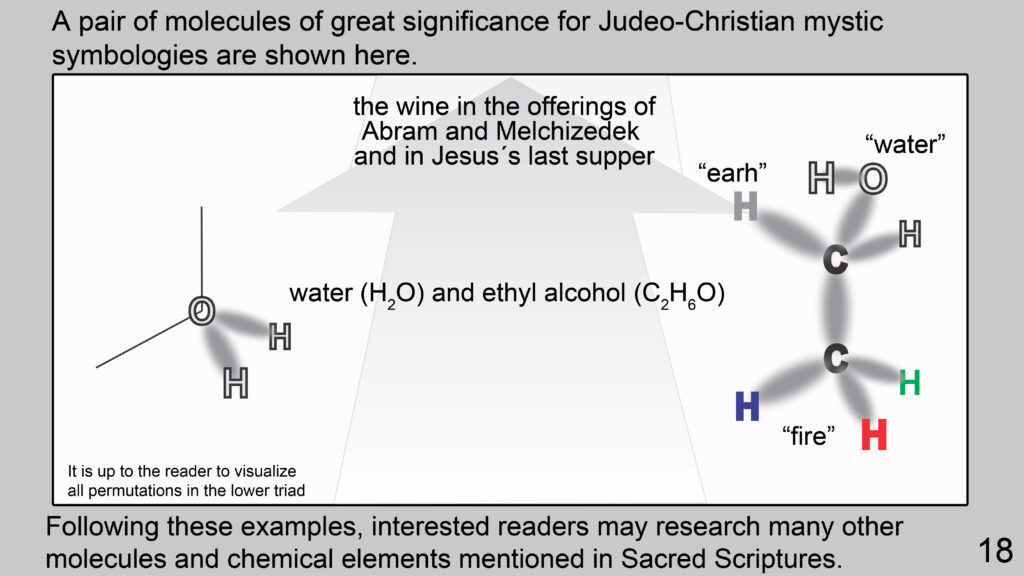
The exteriorization of the elements of alchemy—through functional groups—grows to a staggering scale. One of the countless examples worth mentioning is the exteriorization of the human formula 1&2 in sex hormones. It is even possible to identify both of the human configurations, the heavenly and the earthly one. The upper waters or masculine ones are represented by testosterone, while a pair of cyclically acting feminine hormones exemplify the lower waters.
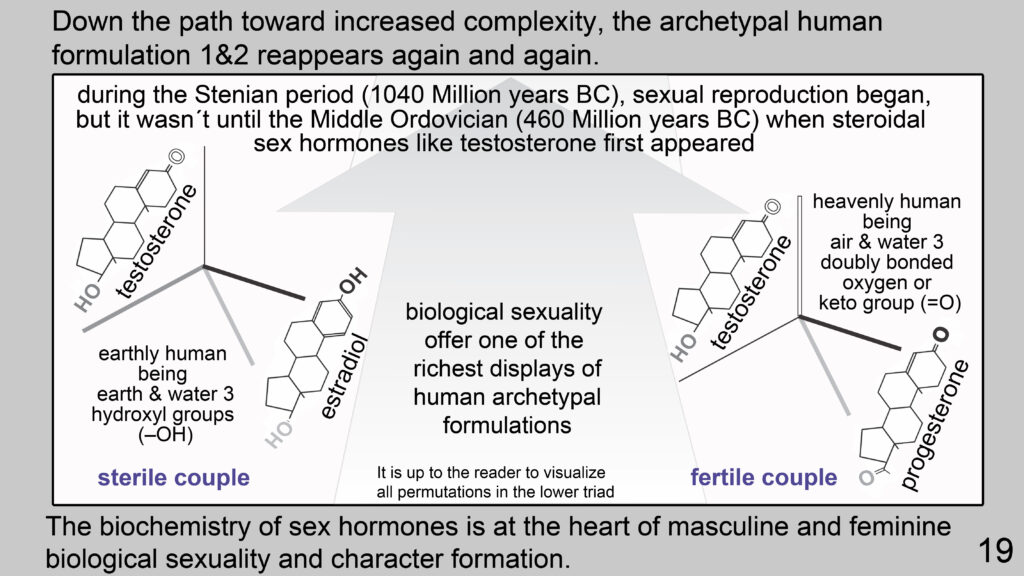
Examples of sterile couples in the Scriptures are Abraham & Sarah, Isaac & Rebecca, Jacob & Rachel, Zechariah & Elizabeth, and Joseph & Mary. The corresponding fertile couples are the Holy Spirit & (Sarah, Rebecca, Rachel, Elizabeth, and Mary). Their offspring are Isaac, Jacob, Benjamin, John the Baptist, and Jesus.
Genetics is another crucial example of how archetypes of alchemy work their way through increasing complexity. There are 2 types of nucleotides biochemically paired, representing the upper and lower waters. The element fire of alchemy is present in 3 of them, having the amino-functional groups (–NH2) attached.
There are, however, 2 systems with adenine, guanine, and cytosine in the lower triad. These 3 nucleotides represent the earthly human and fire archetypes. One of these systems, known as messenger RNA (mRNA), came first in life evolution, and it has the nucleotide uracil as its fourth component. The other system came later and pertains to DNA, where thymine (5-methyl uracil) is the fourth component instead. The fourth component in mRNA might represent the Holy Spirit/air acting in time t, while in DNA, it would correspond to the Anointed One/quintessence acting in perpetuity a.
The essay on Cubic Shrines deals with the interplay of the twin tetrads in the clockwork of reality and prophecy. Beyond the molecular representations is the intriguing exteriorization of the human formula 1&2 in the pair of allosomes.
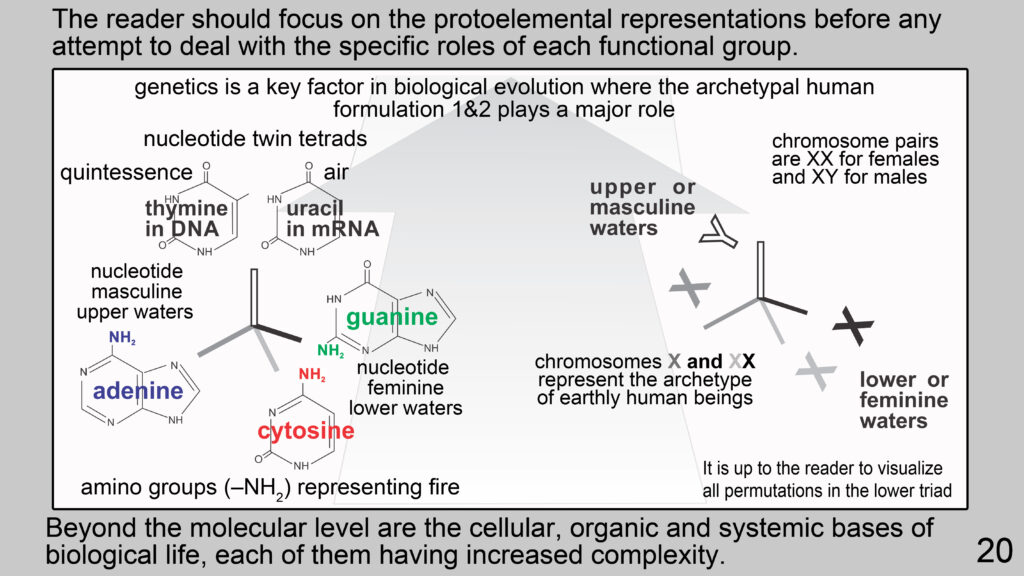
Organs and metabolism are next in the exteriorization path to rule human behavior and beliefs. The human formula has its role in this, but there are numerous organic insinuations regarding the entourage of human existence. The nearly symmetrical human body is one of the most evident reproductions of the feminine trait of Creation in its wholeness.
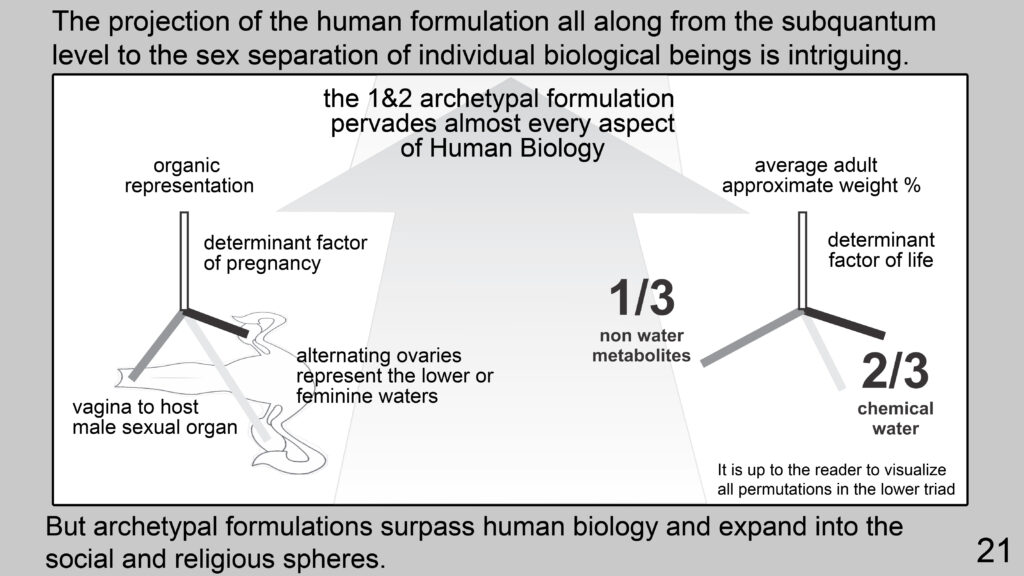
The set of all 1&2 (human) archetypally isomorphous formulations within an individual constitutes the so-called human soul. The human archetype has exploited every biological mutation to tighten its grip on carbon-based life. As a result, the human soul is a local and organic manifestation of its archetypal precursor. Its structure allows the interiorization/exteriorization of archetypes’ deeds through various channels while ensuring coherence all the way through.
Unsurprisingly, human belief systems project themselves beyond human biology as extensions of the archetypal realms. But could it be different? Is human nature capable of escaping archetypal domination? Can carbon-based biology detach from its origin and go beyond its quaternary basis of representation?
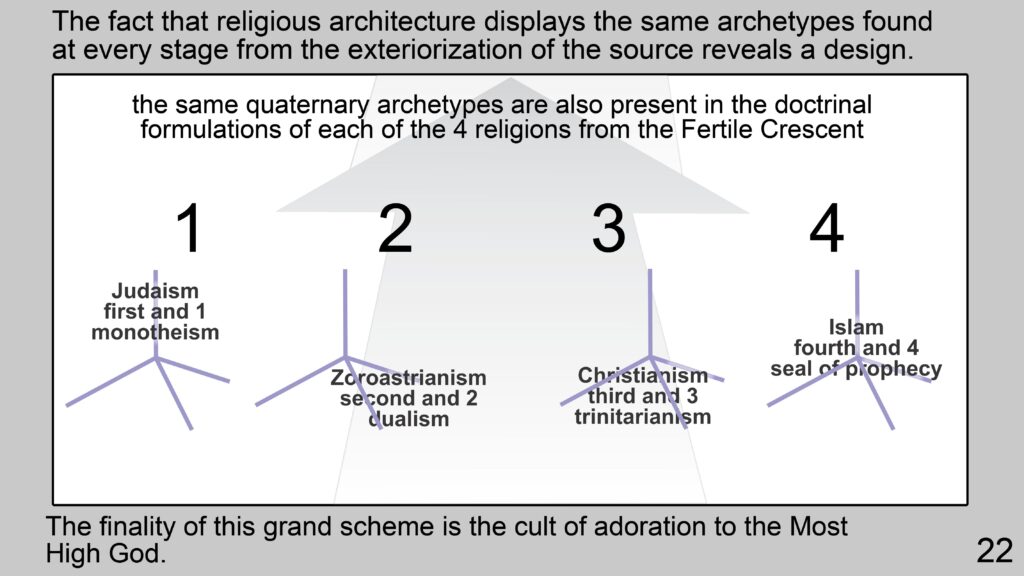
The Alchemy of the 9/11 Attacks and Beyond
While we may not believe in alchemy, others do, and we must cope with the consequences of their beliefs. The best example in recent history is the dramatic event of the 9/11 attacks, starting the twenty-first century. The execution of the attack reveals a design based on the principles of alchemy introduced in this essay, plus some additional considerations.
The 4 static targets represented reality as an encounter between the first (Genesis 1) or adamic creation and the second ("Star" surah of the Koran ayat 47) or christic creation in its first coming (also called new, 2 Corinthians 5:17). However, since the second creation (the anti of the first, physically and properties-wise, its exact opposite) was smaller in quantity, the physical annihilation of the interacting matter was not complete. The remains of the confrontation were the survivors of the deluge surrounded by rough waters—pairs of opposites of the same kind whose energy is in the form of light waves/radiation.
Followers of Abrahamic religions wait for the final annihilation of the interacting matter whose date no one knows, not even the angels of heaven, not the Son, but only the Father, as the Gospel of Mark tells us. In the case of the 9/11 attack, the 4 planes were wanted to represent the second coming of the second creation—the arrival of the Messiah/the second coming of Christ/Raj’a.
There is a pending discussion on whether or not a flaw in the configuration of the airlines was the cause for the failure in completing the quaternary symbolism. It is a fact that the pair of opposing (competing) airlines destined to hit the WTC correctly represented the lower or feminine waters of the triad. However, those aiming at DC and the Pentagon (the upper or masculine waters) should have concurred—like these targets do—instead of opposing each other.
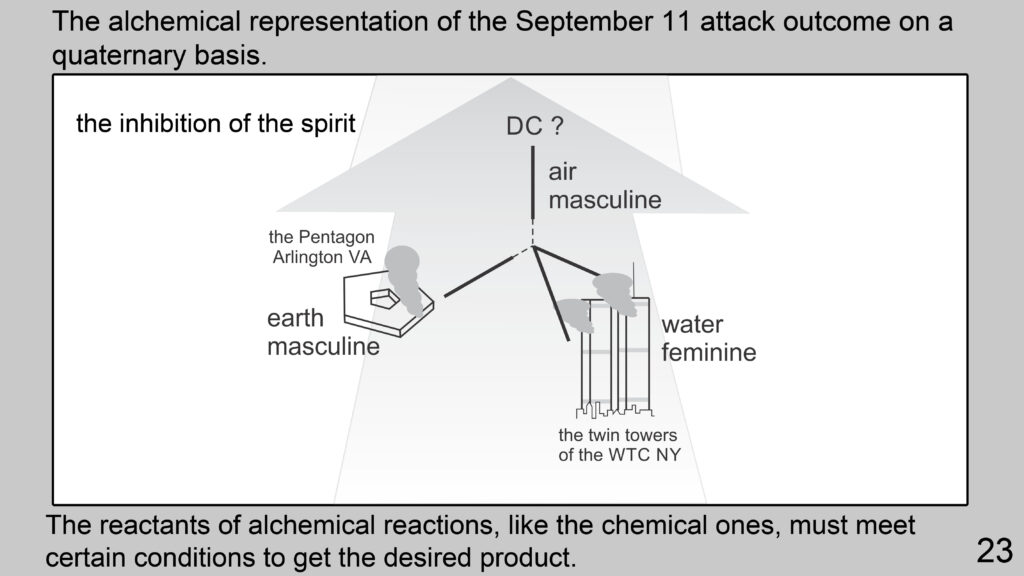
The stars are like signposts foretelling us the final annihilation of interacting matter in a radiating fire once the second coming arrives. Non-interacting matter instead will continue rushing away in its spinning ascension toward the empyreal vault. In the meantime, and despite the subversion of the original plan, Creation’s overarching ultimate goal is the projection of the originating point sources through any path toward the empyrean. Closing a loop where the dark sky beyond the stars is the receding back of God, and the point sources of physical particles are its forthcoming front side.
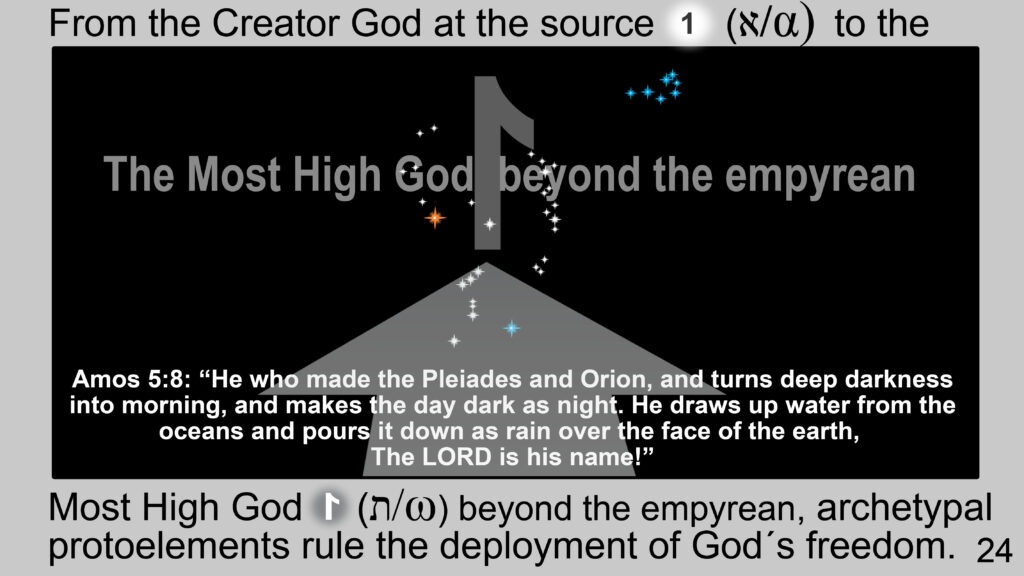
The previous slides on alchemy are just but a small sample of what you will find in Fundamentals of the Creation. This book is a must-read for anyone wanting to understand the origins and meanings of the mysteries and symbols of religion and esotericism.
If you enjoyed this post, don´t miss…


Alchemy´s last update: May 5th, 2021.

